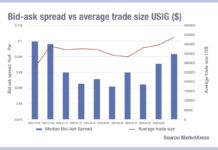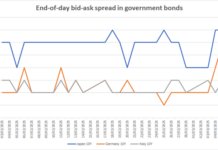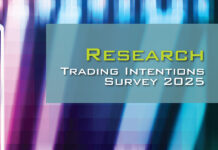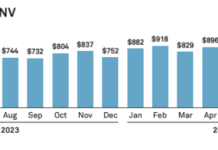David Litchfield, Director of Cboe Derivatives Sales, Cboe

After years of false starts, credit index futures have finally gained traction in institutional portfolios. The Cboe Credit Index Futures ecosystem – comprising Cboe® iBoxx® iShares® $ High Yield Corporate Bond Index (IBHY) futures, Cboe® iBoxx® iShares® $ Investment Grade Corporate Bond Index (IBIG) futures, and Cboe® iBoxx® $ Emerging Market Bond Index (IEMD) futures – is transforming how institutions access credit markets. A recent Cboe Credit Ecosystem workshop brought together market participants to discuss what’s driving adoption of these products and why this time truly is different.
Market evolution creates the foundation
The US corporate bond market has undergone a remarkable transformation over the past decade. According to Kevin McPartland, Head of Fixed Income Market Structure at Coalition Greenwich, electronic trading has grown from less than 15% of total market volume to approximately half today, while average daily volume has more than doubled from $21 billion to $50 billion.
This electronic transformation, combined with the growth of ETFs and pandemic-driven digitisation, has created fertile ground for credit futures to flourish. The numbers tell the story: open interest in IBHY futures reached $780 million in early 2025 – nearly six times higher than a year ago – while IBIG futures hit $479 million, quadrupling year-over-year. The newer IEMD futures further expand the ecosystem into global markets.
Liquidity reaches critical mass
For institutional investors, liquidity has always been the primary barrier to adoption of new credit instruments. Early adopters like Phillip Toews, CEO & President of Toews Corp., who began trading these futures in 2018, have witnessed the evolution from thin volumes to robust liquidity. The watershed moment came recently with a $300 million block trade in investment grade futures in February 2025, decisively demonstrating institutional-scale liquidity capacity.
Bid-offer spreads now consistently hover around 5 basis points for both high yield and investment grade contracts. Even traders like Miguel Bilbao, Founder & CIO at Filión Capital, report executing trades of fifty to sixty lots with negligible market impact. The transition from chicken-and-egg liquidity concerns to a self-reinforcing liquidity cycle appears complete.
Advantages beyond traditional alternatives
What distinguishes credit futures from existing instruments like cash bonds, ETFs, and CDX? The absence of ISDA requirements has opened the door for mandate-restricted institutional investors who cannot use OTC derivatives. For PGIM’s Credit Derivatives PM Chad Cowden, this has solved portfolio management challenges for accounts with compliance restrictions on swap trading.
Capital efficiency represents another significant advantage. Unlike fully-funded ETFs, futures require only margin, which has enabled new business models like Bilbao’s systematic relative value strategies that depend on capital-efficient instruments.
Market representation is superior to synthetic alternatives, with approximately 2,800 bonds in the investment grade index and 1,300 in the high yield index. Nick Godec, Head of Fixed Income Tradables at S&P DJI, notes this translates to threefold cost improvement in high yield and sevenfold in investment grade compared to trading the underlying bonds.
Perhaps most important is the natural connection to the ETF ecosystem. Joyce Choi, Head of iShares Fixed Income Product Strategy at BlackRock, emphasises the structural fungibility between ETFs and futures, creating a seamless arbitrage mechanism that strengthens both markets.
Diverse trading applications
The workshop revealed how different institutions are deploying these instruments in practice. Asset managers like Toews use the contracts for dynamic risk management, allowing them to maintain carefully curated bond positions while efficiently adjusting overall market exposure as conditions change.
PGIM combines credit futures with Treasury futures to isolate spread exposure, viewing them as three-month instruments that complement their longer-term TRS positions and shorter-term ETF trades. Their relative value approach often compares futures pricing to CDX and other credit instruments.
Systematic traders have developed entirely new strategies. Bilbao’s approach capitalises on lead-lag relationships between high yield futures and other duration-sensitive instruments, noting that high yield futures exhibit characteristics that resemble equity beta, volatility sensitivity, and carry potential.
Insurance companies and pension funds are exploring the contracts for capital-efficient hedging and LDI implementation, while institutions restricted from holding ‘40 Act funds have found futures provide a viable alternative to ETFs.
The road ahead
As the market matures, participants anticipate further innovation. Options on futures represent a logical next step, bringing equity-like hedging and income generation strategies to the credit space, and naturally were launched in 2023 to add to the existing derivative ecosystem around the futures contracts. Toews sees this as a significant opportunity, given their experience with options strategies in other asset classes. Term structure products would allow targeted exposure to different parts of the credit curve, similar to how Treasury futures have evolved. Sector-specific futures could enable more precise risk management across industries. Enhancements to analytics platforms are already underway to support more sophisticated trading applications.
Implementation considerations
For institutions considering adoption, the first step is determining whether the goal is a complete cash hedge including rates exposure or a pure credit spread position. From there, implementation requires establishing FCM relationships, integrating with order management systems, and developing appropriate risk frameworks. Bloomberg’s FAIR screen provides a useful tool for analysing implied financing rates, helping traders determine relative value across instruments. For execution, smaller orders can utilise the central limit order book, while larger transactions benefit from block trading mechanisms.
Conclusion
After multiple attempts to establish credit futures, market structure developments and changing investor needs have created the right conditions for success. The acceleration in volumes and diversity of users suggests we’ve reached a genuine inflection point.
David Litchfield, Director of Cboe Derivatives Sales, predicts the credit derivatives landscape will look dramatically different within a few years. For institutional investors seeking efficient credit exposure, the future of credit is no longer on the horizon – it has arrived on exchange.  To learn more about the product and how it trades please reach out to David Litchfield at dlitchfield@cboe.com
To learn more about the product and how it trades please reach out to David Litchfield at dlitchfield@cboe.com
©Markets Media Europe 2025






















